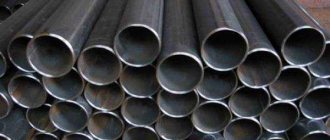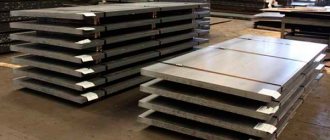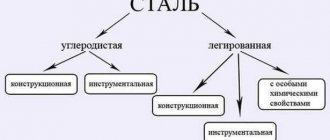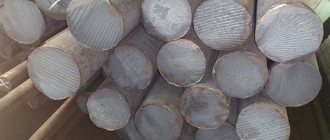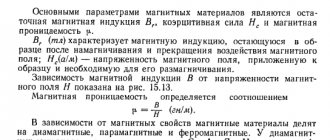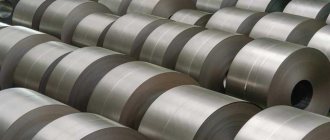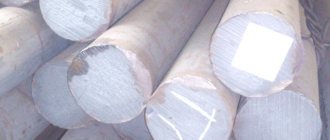Total information
| Substitute |
| Steel: 09G2, 09G2DT, 09G2T, 10G2S. |
| Type of delivery |
| Long products, including shaped steel: GOST 19281-73, GOST 2590-71, GOST 2591-71, GOST 8240-72. Thick sheet GOST 19282-73, GOST 5520-79, GOST 5521-76, GOST 19903-74. Thin sheet GOST 17066-80, GOST 19903-74, GOST 19904-74. Strip GOST 103-76, GOST 82-70. Forgings and forged blanks GOST 1133-71. |
| Purpose |
| Various parts and elements of welded metal structures operating at temperatures from -70 to +425 °C. |
The ability of steel 20 to change and the production of seamless pipes
Manufacturing seamless pipes is an extremely responsible and costly undertaking. They are most often used for the construction of oil and gas pipelines, in high-risk enterprises associated with the chemical industry. In a word, seamless pipes should not have “weak points”.
The characteristics of steel grade 20 allow it to be used for the production of pipes using both hot and cold drawing methods. In the first case, hot-rolled thick-walled pipes with high strength values are obtained. The temperature regime throughout the entire manufacturing process is above 1100ºС. The pipes are cooled for a long time, giving them the final, “GOST” look. (production of pipes from steel 20, GOST 8732-78).
In the second option, the workpiece is heated, but since the temperature is not maintained, the main process takes place at normal temperature. The method is used to produce seamless pipes with thin walls.
Composition and structure
Before studying the composition of steel 09g2s, you need to understand the decoding of the markings:
- The number in front is the amount of the main component of the composition besides iron. In this case, it is carbon, the percentage of which reaches 0.09%. The hardness and strength of the material depends on its quantity.
- The letter after the numerical designation indicates the presence of chemical treatment of the steel during production. A certain amount of manganese is introduced into the composition. The number after the letter indicates the percentage of the introduced component.
- The last symbol indicates the presence of an alloying component. In this case, it is silicon, the percentage of which cannot exceed 1%.
List of additional alloying components, harmful impurities:
- silicon - from 0.5 to 0.8%;
- nickel - no more than 0.3%;
- manganese - from 1.3 to 1.7%;
- phosphorus - no more than 0.035%;
- sulfur - no more than 0.04%;
- chromium - no more than 0.3%;
- arsenic - no more than 0.08%;
- copper - up to 0.3%;
- nitrogen - up to 0.008%.
The amount of iron is from 96 to 97%, carbon - up to 0.12%. The total percentage of alloying components can reach 2.5%. The composition requirements are specified in GOST 27772-88.
09G2S - chemical composition
The steel is classified as silicon-manganese. In accordance with the requirements of GOST 27772-88, it fully complies with C345 steel. The latter is used for the manufacture of building structures.
In accordance with the labeling system adopted in our country, composition 09G2S is deciphered as follows:
- carbon (C) - 0.09%;
- manganese (Mn) - 2%;
- silicon (Si) - no more than 1%.
The amount of alloying components in the steel is not so high, which is why 09G2S steel is classified as low-alloy. This alloy forms the basis of a whole family of steels. For example, - 09g2, 09g2dt, 09g2t, 10g2s and many others. The characteristics of alloys of this family are approximately similar.
Delivery and pickup
We deliver throughout St. Petersburg and the entire Leningrad region. It is possible to deliver the square to other regions by transport companies.
Pickup is possible from our warehouse at 6th Predportovy Proezd, 10 or from production at Sofiyskaya, 80
Application area of the product
A square with these parameters can be used in the manufacture of metal structures, as well as in the production of gratings, fences, and so on.
In some cases, the design can be used to create various architectural structures (special equipment allows you to give the square an aesthetically shaped shape).
Office: St. Petersburg, Sofiyskaya street, building 14, letter A, room 20-N, office 402. Working hours: Mon-Fri from 9:00 to 18:00 | Sat-Sun - day off
The site is not a public offer. We draw your attention to the fact that this website is for informational purposes only and under no circumstances constitutes a public offer as defined by the provisions of Article 437 (2) of the Civil Code of the Russian Federation.
Advantages and disadvantages
The characteristics of 09G2S steel meet modern requirements for the quality of structural materials and allow it to be used for the production of products:
- operated in a wide temperature range - from -70 to +425 degrees;
- experiencing significant force loads;
- subjected to various types of mechanical processing.
Among the main advantages are excellent technological qualities:
- high strength ensuring the safety of the structure;
- durability – the service life of products exceeds 30 years;
- lack of tendency to temper brittleness;
- stable viscosity characteristics when tempering steel;
- good weldability without loss of ductility;
- ease of processing;
- wear resistance;
- low specific gravity;
- efficiency;
- safety;
- resistance to the formation of microcracks;
- The optimum ratio of price and quality.
Like any material, 09G2S steel has numerous pros and cons. These include low corrosion resistance. Therefore, for products that are used in aggressive environments, additional protective coating is necessary.
Specifications
The main technical characteristics of 09G2S steel include:
impact strength
| 590-640 kJ/m2; | |
| elongation at break | 21%; |
| turnover area | 155-255 MPa; |
| tensile strength | 343 MPa; |
| specific gravity | 7850 kg/m3; |
| welded | no limits; |
| hardness of steel 09G2S according to Brinell | 450-490 MPa. |
Physical properties of the alloy
| T | E 10- 5 | a 10 6 | l | r | C | R 10 9 |
| hail | MPa | 1/Grad | W/(m deg) | kg/m3 | J/(kg deg) | Ohm m |
| 20 | ||||||
| 100 | 11.4 | |||||
| 200 | 12.2 | |||||
| 300 | 12.6 | |||||
| 400 | 13.2 | |||||
| 500 | 13.8 | |||||
| T | E 10- 5 | a 10 6 | l | r | C | R 10 9 |
Technological properties
| Forging temperature |
| Start 1250 °C, end 850 °C. |
| Weldability |
| welds without restrictions. Welding methods: RDS, ADS under submerged arc and gas shield, ESW. |
| Machinability |
| In the normalized, tempered state at σB = 520 MPa Ku tv.spl. = 1.6, Ku b.st. = 1.0. |
| Tendency to release ability |
| not inclined |
| Flock sensitivity |
| not sensitive |
Critical point temperature
| Critical point | °C |
| Ac1 | 725 |
| Ac3 | 860 |
| Ar3 | 780 |
| Ar1 | 625 |
Impact strength
Impact strength, KCU, J/cm2
| Delivery condition, heat treatment | +20 | -40 | -70 |
| GOST 19281-73. Long and shaped rolled products with a cross section of 5-10 mm. | 64 | 39 | 34 |
| GOST 19281-73. Long and shaped rolled products with a cross section of 10-20 mm. | 59 | 34 | 29 |
| GOST 19281-73. Long and shaped rolled products with a cross-section of 20-100 mm. | 59 | 34 | |
| GOST 19282-73. Sheets and strips with a cross section of 5-10 mm. | 64 | 39 | 34 |
| GOST 19282-73. Sheets and strips with a cross section of 10-160 mm. | 59 | 34 | 29 |
| GOST 19282-73. Sheets after hardening, tempering (Transverse samples) with a cross section of 10-60 mm | 49 | 29 |
Endurance limit of steel 09G2S
| σ-1, MPa | σB, MPa |
| 235 | 475 |
Yield strength of steel 09G2S
| Test temperature, °C /σ0.2 | ||||||
| 250 | 300 | 350 | 400 | |||
| 225 | 195 | 175 | 155 | |||
Weldability
No limits
Welding with restrictions
Difficult to weld
Heating
Heat treatment
| No | up to 100–1200С | 200–3000С |
| No | There is | annealing |
Manufacturing
The basis for the manufacture of the material is cast iron. It goes through a long optimization process, during which the amount of carbon in the composition increases and the basic properties of the metal improve. To achieve certain technical characteristics, additional alloying additives are added.
Manufacturing technologies:
- Open-hearth method. An industrial furnace is loaded with scrap, cast iron, charge, and additional components. A pile of metal is melted using a torch of burning fuel. Once the scrap is melted, alloying components are added to the bath. When carrying out the procedure, special open-hearth furnaces are used, which can smelt up to 900 tons of metal at a time.
- Electrothermal method. During production, an industrial electric furnace is used, with which you can accurately set the heating mode and control the metal production process. The main advantage of the technology is the ability to obtain metal with the lowest content of harmful impurities (phosphorus, sulfur). Thanks to the ability to set very high heating temperatures, it is possible to obtain specialized types of steel with unique technical characteristics.
- Converter. Molten cast iron is poured into the melting apparatus and purged with oxygen. The impurities contained in the cast iron begin to oxidize. Oxidation releases a large amount of heat, which increases the overall temperature to 1600 °C.
Weldability groups of steels
The weldability of steel is a characteristic indicating the possibility of welding metal with satisfactory mechanical properties without the formation of cracks. There are four groups of weldability of steels :
- good weldability
- satisfactory weldability
- limited weldability
- poor weldability
Typically, steels with low carbon content have good weldability, while those with high carbon content have limited or poor weldability.
Areas of application
Areas of application:
- Manufacturing of parts that are subject to heavy loads - metal corners, channels, axles, beams.
- Assembly of vehicles, industrial equipment, construction of metal structures. Due to their resistance to different temperatures, the structures can be used in different climatic conditions.
- Application in the chemical industry. The material is resistant to chemicals.
- Manufacturing of poles, fences, frames for public benches, gazebos, swings, children's slides, horizontal bars.
- Production of heating equipment, steam boilers, machines for agricultural activities.
To use the material in other areas of industry, various alloying components are added to its composition.
Steel 09g2s: characteristics and application
The main areas of use of this brand: sheet and shaped products. For hot-rolled strip, GOST 103-2006 standards are used, but steel circles are in accordance with GOST 2590-2006.
As already noted, steel 09g2s and analogues are easy to weld. The characteristics already listed allow the use of this material for products that require high wear resistance: beams, channels, corners.
Brand 09g2s, its technical characteristics, are necessary in the creation of vehicles, construction, oil and chemical industries. A wide temperature range allows the material to be used where severe deformations occur over a long service life. At the same time, the limiting temperature of -70 degrees facilitates the use of products made from St. 09g2s in harsh climatic conditions.
Steel 09g2s is used in the construction of RVS for storing petroleum products in the North
Steel 09g2s-15 also fits this description well. It is used for all of the above points. It only remains to add that in addition to welding, installation can be carried out using bolted connecting elements. The metal's resistance to chemical influences makes it interesting in the relevant industry. At the same time, high mechanical qualities are used for the construction of bridges, roads, port stations, etc.
The 09g2s-12 brand is also popular among builders. It also has stable plastic properties. It is distinguished by a special chemical composition, which includes arsenic. Used for the manufacture of pipeline fittings. Cannot be used in the food industry.
In the north of Russia, many kilometers of pipelines were built using just this brand. There, more than anywhere else, frost resistance and easy weldability of products are useful. This allows you to create complex, at the same time socially significant objects (metal structures) from 09g2s and analogues.
At the same time, for cities with a temperate or continental climate, steel 09g2s according to GOST standards of various numbers is suitable for beautifying streets. Square pipe is extremely popular as fencing, posts for billboards, installation of mobile trading platforms, and much more. For the same purposes, the rectangular configuration of products is used.
Steel 09g2s, the characteristics of which have already been discussed in some detail in this presentation, is of interest to welders, regardless of the method of performing work. Flanges made of this material are especially popular. Features of the work are described in GOST 19281-73. The craftsmen are quite welcoming to the news about the need to work with this brand.
The boiler tank itself is made of steel 09g2s
Steel 09g2s with different strength classes can be used for the production of steam boilers, as well as equipment used in the agricultural complex. Details about the requirements for steel 09g2s in GOST-5520 79.
An additional reason for using alloys of this brand is high efficiency, achieved not only due to low cost of production. The ease and speed of construction of buildings, structures, installation of equipment also allows you to optimize the costs of enterprises in various industries.
Read also: Setting up channels on a satellite tuner
What does the transcript look like?
Knowing the labeling makes it possible to directly understand what exactly is offered by the manufacturer and what features the product has. From a technical point of view, the marking 09g2s means the following:
- 09 - exact proportion of carbon in the total alloy;
- G2 - presence of manganese and its fluctuation in the total volume - 2%;
- C—presence of silicon, the proportion of which does not exceed 1%.
However, one should not think that the composition of steel includes only those elements that are indicated in the marking.
In addition to manganese and silicon, the overall composition is supplemented by sulfur, nitrogen, nickel, copper and phosphorus. However, the share of additional components rarely exceeds 1%, so they are not mentioned in the labeling.
Also, decoding concerns not only doping, but also other criteria. For example, the following should be included here:
- Structure and changes after the hardening process;
- Main purpose;
- Manufacturing method;
- Chem. composition of the material.
As a result, there are analogues for these indicators on the domestic market. You can often hear that 09g2s is steel 345. However, the second indicator is intended for builders and does not mean the chemical composition, but the fluidity indicator, which corresponds to the steel standard.
Recycled raw materials
The variety of products is great, the entire range is easy to see simply by Googling or visiting any pipe bulletin board or for rolled metal products. A huge number of channels, corners, etc. Moreover, it is not always clear how the authors set the cost.
For example, the question with the content: “steel 09g2s price per ton” is simply baffling. After all, the decoding does not speak about the type of rental, nor about its other properties and qualities.
By the way, we have already written an article about scrap steel 09g2s - it describes in more detail the recycling of this steel.
Moreover, there are excellent categories when they want to sell old scrap 09g2s, new products, or simply materials that have already become unusable. Therefore, the price for this type of metal is rarely fixed. Only what is recycled is taken by weight. Channels and other items are accepted individually as business scrap with a price. Rolled sheets are measured by footage. But in principle, these data can also be calculated by weight, subject to the purchase of large quantities. But then both parties run the risk of cutting prices, because the number of products may differ slightly with this method.
Analogs
Using low-alloy steels grade 09g2s, like other Russian-made metals containing carbon and manganese, it is possible to produce various types of rolled products and pipe products.
Class. Low-alloy structural steel for welded structures.
Some foreign analogues: 9MnSi5, 09G2S, 9SiMn16.
The offered metal meets both the requirements of GOST and international standards. Before shipment, each batch of goods undergoes a thorough check for defects, as well as compliance with the declared chemical composition. We are ready to provide all the necessary documents for rafting.
Material 09G2S - exact and closest foreign analogues
Bulgaria
Hungary
Germany
China
Romania
Japan
| BDS | MSZ | DIN, WNR | G.B. | STAS | JIS |
| 09G2S | VH2 |
| 9MnSi5 |
Steel 09G2S - domestic analogues
| Rolled metal grade | Substitute |
| 09G2S | 09G2, 09G2DT, 09G2T, 10G2S |
Comparison with another steel grade
For example, for 09g2s and st3 the difference is determined primarily by the carbon content. For St3sp it is 10-20 times higher than what is found in the low-alloy alloy.
St3sp – refers to carbon alloys. This grade of steel is characterized by high brittleness and rapid destruction at low temperatures. If the brand being described has a lower limit of -70 degrees, then the object of comparison is only -20.
The quality of St3sp is ordinary, which indicates a likely high presence of sulfur and phosphorus. Then, like 09g2s is high quality. All other advantages are already in the previous description. It only remains to note that the cost of this brand is significantly higher than the price of St3sp.
Video about low alloy steels:
Differences
Steels differ in the content of chemical elements, which entails differences in application.
St20 expands under the influence of high temperatures and becomes plastic. At low temperatures it becomes brittle. It is a cheaper brand compared to 09g2s.
St.09g2s retains its original characteristics and is more wear-resistant. Therefore, it is used for the production of steel elements, which are subject to increased requirements for resistance and temperature changes.
Source
Density of different types of steel
A table of densities of common types of steel at room temperature is provided. The density of steel depends significantly on the type, which is determined by its chemical composition and purpose.
Light steels with low density include some alloyed, heat-resistant and stainless steels. The minimum density of common grades of such steels is 7640-7670 kg/m3.
The presence of a large amount of nickel in steel makes its density higher. For example, the density of nickel-based alloys can reach 8500 kg/m3. The heaviest is high-speed tool steel. It contains heavy metals such as tungsten and molybdenum. The density of such steel varies in the range from 8000 to 8800 kg/m3.
Steel density by type Steel typeExamples Density, kg/m3
| Carbon quality | Art.08, Art.10, Art.15, 20, 40, 50, 85, 15K, A12, A30, OS | 7800-7870 |
| Low alloy steels | 15G, 40G, 10G2, 16GS, 18G2S, 45G2, 15Х, 35Х, 50Х | 7730-7850 |
| Alloy steels | 18ХГТ, 25ХГМ, 40ХС, 35ХМ, 40ХФА, 20ХН, 15Н5А | 7640-7880 |
| Purpose steels | 65G, 55S2, 60S2G, 70S2ХА, ШХ15, EI 229 | 7650-7850 |
| Stainless, heat-resistant and heat-resistant | 03Х8СУЦ, 12Х18Н10Т, 10Х12НД, 03Н18К9М5Т | 7670-8000 |
| Iron-nickel alloys | ХН32Т, ХН35ВТК, ХН45У, 06ХН46Б, DI65 | 7700-8170 |
| Nickel-based alloys | EI 929, KhN60Yu, EP 709, KhN70Yu, KhN78T, KhN80TBYu | 7900-8570 |
| Carbon and alloy | U7, U8, U10, 9ХС, ХВГ | 7745-7850 |
| Die steel | Х6ВФ, Х12, 7Х3, 3Х3М3Ф, EP 761, EI 958, DI 37 | 7700-7800 |
| Roll steel | 9Х, 9Х2В, 55Х, 60ХН, 75ХМ, 7Х2СМФ | 7800-7900 |
| High speed | 11R3AM3F2, R6M3, R9, R12, R18, R18K5F2 | 8000-8800 |
| Steels for castings | 15L, 30L, 70L, 40HL, 25GSL, 05Х26Н6М2Д2АБФЛ | 7730-7850 |
| Nickel-based alloys for castings | KhN58VKMTYuBL, KhN65VMTYuL, TsNK 7P, TsNK 17P | 8000-8790 |
What electrodes should be used to weld a pipe?
When working, you cannot do without consumables - electrode rods. They are a metal rod, on the surface of which a special coating (coating) is applied. It provides a protective layer (film) that prevents oxygen and nitrogen from entering the seam.
Types of equipment by type of protective layer:
- with rutile film - needed for creating fillet welds and tacks;
- with cellulose coating - used for fastening objects with large diameters. Allows you to create circular, vertical seams;
- with a rutile-cellulose layer - a combination that is in demand when making complex structures (for example, a vertical seam from top to bottom).
When selecting rods, several factors are taken into account: operating mode, equipment power, conditions under which the work is performed, metal quality, and others. The choice of core is strictly regulated by special documents.
Electrodes for pressure pipelines
For connecting pipe sections from steel twenty, rods E42A UONI-13/45 are optimal. If they contain materials 30ХМА, 20Х3МВФ, it is better to choose equipment EP-60, TsL-19ХМ, VSN-2.
Also for joining high-pressure lines, grades OK 74.70 and OK 53.70 are used. The latter are coated with a special flux, allowing for high-quality processing of networks that are created on the basis of low-carbon steels. The result is a welded joint that has increased ductility and good impact strength.
Electrodes for gas pipelines
Several brands are used for gas pipelines. OK-46 is considered the most universal. It provides a high-quality seam, therefore it is often used when processing critical structures (including in shipbuilding and aircraft construction).
Strong, durable seams in rotating and non-rotating areas of gas mains make it possible to obtain grades LB-52, UONI-1355, MTG-01K. These rods are characterized by a stable arc, easy removal of slag, and low spatter.
Electrodes for oil pipelines
Among domestic elements, certified LEZ LBgp brands are most widespread. Devices with a diameter of 2.5 - 4 mm are coated with silicon, sulfur, carbon, and manganese.
Density of common grades of steel at different temperatures
The table shows the density values of steel of common grades depending on temperature. It should be noted that the density of steel changes little when its temperature changes. The density of various steel grades in kg/m3 dimensions is given in the table at temperatures from 20 to 900°C.
When steel is heated, it increases in volume and its density becomes less. For example, the density of stainless steel 12Х18Н9 at 20°С is equal to 7900 kg/m3 or 7.9 g/cm3, and at a temperature of 900°С the density of this steel decreases and becomes equal to 7510 kg/m3 or 7.51 g/cm3. Of the steels presented in the table, we can distinguish the lightest steel with the minimum density. Such steel is stainless heat-resistant steel 15Х25Т (Х25Т, EI439), the density of which at room temperature is 7600 kg/m3 or 7.6 g/cm3. The heaviest is P18 tool steel with a density of 8800 kg/m3 (8.8 g/cm3) at room temperature (20°C).
The average density of structural steel at room temperature is 7700...7900 kg/m3. For example, the density of steel 20 is 7856 kg/m3 at a temperature of 20°C. The density of steel is generally quite close to the density of iron since this metal is the basis of this alloy.
Table of steel density values by grade Steel grade Temperature, °Steel density, kg/m3
| 02Х17Н11М2 | 20 | 8000 |
| 02X22N5AM3 | 20 | 8000 |
| 03Н18К9М5Т | 20 | 8000 |
| 03Х11Н10М2Т | 20 | 8000 |
| 03Х13Н8Д2ТМ (EP699) | 20 | 7800 |
| 03X24N6AM3 (ZI130) | 20 | 8000 |
| 06Х12Н3Д | 20 | 7810 |
| 06ХН28МДТ (0Х23Н28М3Д3Т, EI943) | 20 | 7960 |
| 07Х16Н6 (Х16Н6, EP288) | 20 | 7800 |
| Steel 08 | 20…100…200…300…400…500… 600…700…800…900 | 7871…7846…7814…7781…7745…7708… 7668…7628…7598…7602 |
| 08GDNFL | 20 | 7850 |
| 08kp | 20…100…200…300…400…500… 600…700…800…900 | 7871…7846…7814…7781…7745…7708… 7668…7628…7598…7602 |
| 08Х13 (0Х13, EI496) | 20…100…200 | 7760…7740…7710 |
| 08Х17Т (0Х17Т, EI645) | 20 | 7700 |
| 08Х17Н13М2Т (0Х17Н13М2Т) | 20…100…200…300…400…500… 600…700 | 7900…7870…7830…7790…7750…7700… 7660…7620 |
| 08Х18Н10 (0Х18Н10) | 20 | 7850 |
| 08Х18Н10Т (0Х18Н10Т, EI914) | 20 | 7900 |
| 08Х22Н6Т (0Х22Н5Т, EP53) | 20 | 7700 |
| 3Х3М3Ф | 20…100…200…300…400…500… 600…700…800…900 | 7828…7808…7783…7754…7721…7684… 7642…7597…7565…7525 |
| 4Х4ВМФС (DI22) | 20…100…200…300…400…500… 600…700…800…900 | 7808…7786…7757…7726…7693…7658… 7624…7581…7554…7550 |
| 4Х5МФ1С (EP572) | 20…100…200…300…400…500… 600…700…800…900 | 7716…7692…7660…7627…7593…7559… 7523…7490…7459…7438 |
| 9ХС | 20 | 7830 |
| 9Х2МФ | 20 | 7840 |
| Steel 10 | 20…100…200…300…400…500… 600…700…800…900 | 7856…7832…7800…7765…7730…7692… 7653…7613…7582…7594 |
| 10G2 | 20 | 7790 |
| 10kp | 20…100…200…300…400…500… 600…700…800…900 | 7856…7832…7800…7765…7730…7692… 7653…7613…7582…7594 |
| 10Х11Н20Т3Р (ЭИ696) | 20 | 7900 |
| 10Х11Н23Т3МР (EP33) | 20 | 7950 |
| 10Kh12N3M2FA(Sh) (10Kh12N3M2FA-A(Sh)) | 20 | 7750 |
| 10Х13Н3М1Л | 20 | 7745 |
| 10Х14Г14Н4Т (Х14Г14Н3Т, EI711) | 20 | 7800 |
| 10Х17Н13М2Т (Х17Н13М2Т, EI448) | 20…100…200…300…400…500… 600…700 | 7900…7870…7830…7790…7750…7700… 7660…7620 |
| 10Х18Н18У4Д (EP841) | 20 | 7630 |
| 12MH | 20…100…200…300…400…500… 600…700 | 7850…7830…7800…7760…7730…7690… 7650…7610 |
| 12ХН2 | 20 | 7880 |
| 12ХН3А | 20…100…200…300…400…500…600 | 7850…7830…7800…7760…7720…7680…7640 |
| 12X2MFB (EI531) | 20 | 7800 |
| 12X1MF (EI575) | 20…100…200…300…400…500… 600…700…800…900 | 7800…7780…7750…7720…7680…7650… 7600…7570…7540…7560 |
| 12Х2Н4А | 20…100…300…400…600 | 7840…7820…7760…7710…7630 |
| 12Х13 (1Х13) | 20…100…200…300…400…500… 600…700…800…900 | 7720…7700…7670…7640…7620…7580… 7550…7520…7490…7500 |
| 12X17 (X17, EZh17) | 20 | 7720 |
| 12Х18Н9 (Х18Н9) | 20…100…200…300…400…500… 600…700…800…900 | 7900…7860…7820…7780…7740…7690… 7650…7600…7560…7510 |
| 12Х18Н9Т (Х18Н9Т) | 20…100…200…300…400…500… 600…700…800…900 | 7900…7860…7820…7780…7740…7690… 7650…7600…7560…7510 |
| 12Х18Н10Т | 20 | 7900 |
| 12Х18Н12Т (Х18Н12Т) | 20…100…200…300…400…500… 600…700 | 7900…7870…7830…7780…7740…7700… 7850…7610 |
| 12X25N16G7AR (EI835) | 20 | 7820 |
| 13Х11Н2В2МФ-Ш (ЭИ961-Ш) | 20 | 7800 |
| 14Х17Н2 (1Х17Н2, EI268) | 20 | 7750 |
| Steel 15 | 20…100…200…300…400…500… 600…700…800…900 | 7850…7827…7794…7759…7724…7687… 7648…7611…7599…7584 |
| 15G | 20 | 7810 |
| 15kp | 20…100…200…300…400…500… 600…700…800…900 | 7850…7827…7794…7759…7724…7687… 7648…7611…7599…7584 |
| 15K | 20 | 7850 |
| 15L | 20 | 7820 |
| 15X | 20…100…200…400…600 | 7830…7810…7780…7710…7640 |
| 15ХМ | 20…100…200…300…400…500…600 | 7850…7830…7800…7760…7730…7700…7660 |
| 15HF | 20…100…200…300…400…500… 600…700 | 7760…7730…7710…7670…7640…7600… 7570…7530 |
| 15Х5М (12Х5МА, Х5М) | 20…100…200…300…400…500…600 | 7750…7730…7700…7670…7640…7610…7580 |
| 15X12VNMF(EI802, EI952) | 20…100…200…300…400…500… 600…700 | 7850…7830…7800…7780…7760…7730… 7700…7670 |
| 15Х25Т (Х25Т, EI439) | 20 | 7600 |
| 16GS | 20 | 7850 |
| 17Х18Н9 (2Х18Н9) | 20 | 7850 |
| 18Х2Н4МА (18Х2Н4ВА) | 20…100…200…300…400…500…600 | 7950…7930…7900…7860…7830…7800…7760 |
| 18Kh12VMBFR-Sh (EP 993-Sh) | 20 | 7850 |
| 18ХГТ | 20 | 7800 |
| Steel 20 | 20…100…200…300…400…500… 600…700…800…900 | 7856…7834…7803…7770…7736…7699… 7659…7617…7624…7600 |
| 20G | 20 | 7820 |
| 20K | 20 | 7850 |
| 20L | 20 | 7850 |
| 20kp | 100…200…300…400…500…600… 700…800…900 | 7834…7803…7770…7736…7699…7659… 7617…7624…7600 |
| 20X | 20…100…200…400…600 | 7830…7810…7780…7710…7640 |
| 20ХГР | 20 | 7800 |
| 20ХГСА | 20 | 7760 |
| 20HML | 20…100…200…300…400…500…600 | 7800…7780…7750…7720…7690…7650…7620 |
| 20ХН3А | 20…100…300…600 | 7850…7830…7760…7660 |
| 20Х2Н4А | 20 | 7850 |
| 20Х3МВФ (EI415, EI579) | 20…400…500…600 | 7800…7690…7660…7620 |
| 20X5ML | 20 | 7730 |
| 20Х13 (2Х13) | 20…100…200…300…400…500… 600…700…800 | 7670…7660…7630…7600…7570…7540… 7510…7480…7450 |
| 20Х13Л | 20 | 7740 |
| 20Х20Н13 (Х23Н13, EI319) | 20…100…600…800 | 7820…7790…7580…7480 |
| 20Х20Н14С2 (Х20Н14С2, EI211) | 20…100…600…700…800…900 | 7800…7760…7550…7510…7470…7420 |
| 20Х23Н18 (Х23Н18, EI417) | 20…400…500…600…700…900 | 7900…7760…7720…7670…7620…7540 |
| 20Х25Н20С2 (Х25Н20С2, EI283) | 20…100…800…900 | 7720…7680…7440…7390 |
| Steel 25 | 20 | 7820 |
| 25L | 20 | 7830 |
| 25ХГСА | 20…100…200…300…400…500… 600…700 | 7850…7830…7790…7760…7730…7690… 7650…7610 |
| 25Х1МФ (EI10) | 20…200…400…600 | 7840…7790…7720…7650 |
| 25Х2М1Ф (EI723) | 20…100…200…300…400…500…600 | 7800…7780…7750…7720…7680…7650…7600 |
| 25Х13Н2 (2Х14Н2, EI474) | 20 | 7680 |
| Steel 30 | 20 | 7850 |
| 30G | 20 | 7810 |
| 30L | 20 | 7810 |
| 30X | 20…100…200…300…400…500… 600…700…800…900 | 7820…7800…7770…7740…7700…7670… 7630…7590…7610…7560 |
| 30ХМ, 30ХМА | 20…100…200…300…400…500 | 7820…7800…7770…7740…7700…7660 |
| 30ХН3А | 20…100…200…300…400…500… 600…700…800…900 | 7850…7830…7800…7760…7730…7700… 7670…7690…7650…7600 |
| 30Х13 (3Х13) | 20…100…200…300…400…500… 600…700…800…900 | 7670…7650…7620…7600…7570…7540… 7510…7480…7450…7460 |
| 31Х19Н9МВБТ (ЭИ572) | 20 | 7960 |
| 33ХС | 20 | 7640 |
| 34ХН3М, 34ХН3МА | 20…100…200…400…600 | 7830…7810…7780…7710…7650 |
| Steel 35 | 20…100…200…300…400…500… 600…700…800…900 | 7826…7804…7771…7737…7700…7662… 7623…7583…7600…7549 |
| 35G2 | 20 | 7790 |
| 35L | 20 | 7830 |
| 35ХГСЛ | 20 | 7800 |
| 35ХМ | 20…100…200…400…600 | 7820…7800…7770…7770…7630 |
| 35HML | 20 | 7840 |
| 35ХМФЛ | 20 | 7820 |
| 37Х12Н8Г8МФБ (ЭИ481) | 20 | 7850 |
| 38ХА | 20…200…600 | 7850…7800…7650 |
| 38ХН3МФА | 20 | 7900 |
| 38ХС | 20 | 7800 |
| 38Х2МУА (38ХМУА) | 20 | 7710 |
| Steel 40 | 20 | 7850 |
| 40G | 20 | 7810 |
| 40G2 | 20 | 7800 |
| 40L | 20 | 7810 |
| 40X | 20…200…500 | 7850…7800…7650 |
| 40HL | 20 | 7830 |
| 40ХН | 20…100…200…300…400 | 7820…7800…7770…7740…7700 |
| 40ХН2МА (40ХНМА) | 20 | 7850 |
| 40ХС | 20…100…200…400…600 | 7740…7720…7690…7620…7540 |
| 40HFA | 20 | 7810 |
| 40Х9С2 (4Х9С2, ESH8) | 20…100…200…400…600…800 | 7630…7610…7580…7510…7440…7390 |
| 40Х10С2М (4Х10С2М, EI107) | 20…100…800 | 7620…7610…7430 |
| 40Х13 (4Х13) | 20…100…200…300…400…500… 600…700…800 | 7650…7630…7600…7570…7540…7510… 7480…7450…7420 |
| 40Х24Н12СЛ (ЭИ316Л) | 20 | 7800 |
| Steel 45 | 20…100…200…300…400…500… 600…700…800 | 7826…7799…7769…7739…7698…7662… 7625…7587…7595 |
| 45G2 | 20 | 7810 |
| 45L | 20 | 7800 |
| 45X | 20 | 7820 |
| 45ХН | 20 | 7820 |
| 45Х14Н14В2М (ЭИ69) | 20…200…400…600…800 | 8000…7930…7840…7760…7660 |
| Steel 50 | 20 | 7810 |
| 50G | 20 | 7810 |
| 50G2 | 20 | 7500 |
| 50L | 20 | 7820 |
| 50X | 20 | 7820 |
| 50ХН | 20 | 7860 |
| 50HFA | 20…100…200…300…400…500…600 | 7800…7780…7750…7720…7680…7650…7610 |
| Steel 55 | 20 | 7820 |
| Steel 60 | 20 | 7800 |
| 60С2, 60С2А | 20…100…200…300…400…500 | 7680…7660…7630…7590…7570…7520 |
| 65G (ZMI3) | 20…100…200…400 | 7850…7830…7800…7730 |
| 75ХМ | 20 | 7900 |
| 95Х18 (9Х18, EI229) | 20…100…800 | 7750…7730…7540 |
| Х23У5Т | 20 | 7210 |
| ХН32Т (EP670) | 20 | 8160 |
| ХН35ВТ (ЭИ612) | 20 | 8164 |
| KhN35VTYu (EI787) | 20 | 8040 |
| ХН45У (EP747) | 20 | 7700 |
| KhN55VMTKYu (EI929), KhN55VMTKYu-VD (EI929-VD) | 20 | 8400 |
| KHN58VKMTUBL (TsNK8MP) | 20 | 8210 |
| ХН60У (ЭИ559А) | 20 | 7900 |
| ХН60ВТ (ЭИ868) | 20 | 8350 |
| KHN60KVMYUTBL (TsNK21P) | 20 | 8110 |
| KHN60KVMYUTL (TsNK7P) | 20 | 8200 |
| KHN62MBVYU (EP709) | 20 | 8700 |
| KhN62MVKYu (EI867), KhN62MVKYu-VD (EI867-VD) | 20 | 8570 |
| KHN64VMKYUTL (ZMI3) | 20 | 8250 |
| KHN65VKMBYUTL (EI539LMU) | 20 | 8220 |
| KhN65VMTYu (EI893) | 20 | 8790 |
| KHN65VMTYUL (EI893L) | 20 | 8790 |
| KHN65KMVYUTL (ZhS6K) | 20 | 8200 |
| KhN67MVTYu (EP202, EI445R) | 20 | 8360 |
| KHN70KVMYUTL (TsNK17P) | 20 | 8000 |
| KhN70VMTYuF (EI826), KhN70VMTYuF-VD (EI826-VD) | 20 | 8470 |
| KhN70VMUT (EI765) | 20 | 8570 |
| ХН70У (ЭИ652) | 20 | 7900 |
| KHN73MBTYU (EI698) | 20 | 8320 |
| ХН75ВМУ (ЭИ827) | 20 | 8430 |
| KHN77TYUR (EI437B) | 20 | 8200 |
| ХН78Т (EI435) | 20 | 8400 |
| ХН80ТБУ (ЭИ607) | 20 | 8300 |
| KhN80TBYuA (EI607A) | 20 | 8300 |
| Х15Н60-Н | 20 | 8200 |
| Х20Н80-Н | 20 | 8400 |
| Х27У5Т | 20 | 7190 |
| HVG | 20…100…300…600 | 7850…7830…7760…7660 |
| A12 | 20 | 7830 |
| R6M3 | 20 | 8000 |
| R6M5K5 | 20 | 8200 |
| P9 | 20 | 8300 |
| R9M4K8 | 20 | 8300 |
| P12 | 20 | 8300 |
| P18 | 20 | 8800 |
| U7, U7A | 20 | 7830 |
| U8, U8A | 20…100…200…300…400…500… 600…700…800 | 7839…7817…7786…7752…7714…7676… 7638…7600…7852 |
| U9, U9A | 20…100…200…300…400…500… 600…700…800…900 | 7745…7726…7717…7690…7686…7655… 7622…7586…7568…7523 |
| U10, U10A | 20 | 7810 |
| U12, U12A | 20…100…200…300…400…500… 600…700…800…900 | 7830…7809…7781…7749…7713…7675… 7634…7592…7565…7489 |
| ШХ15 | 20…100…200…300…400…500 | 7812…7790…7750…7720…7680…7640 |
| SHH15SG | 20 | 7650 |
Density of carbon steels
The density of carbon steel at room temperature ranges from 7.83 to 7.87 g/cm3. The table shows the density values of the following carbon steels: steel 08KP, steel 08, steel 20, steel 40, steel U8, steel U12.
The density values in the table are indicated depending on the temperature - in the range from 0 to 1100°C. When steel is heated, it becomes less dense. For example, the density of steel 20 is 7859 kg/m3 at a temperature of 15°C, and when heated to a temperature of 1100°C, the density of this steel decreases to 7496 kg/m3.
Note: The density of carbon steels in the table is expressed in units of kg/m3.
Density of low alloy steels
The density values of the following low-alloy steels are presented: steel 15М, 12МХ, 15ХМ, 15ХФ, 30Х, 30Н3, 30ХН3, 12Х5СМА, Х6М, 30Г2, 50С2Г. The average density of low-alloy steels ranges from 7725 to 7855 kg/m3 at a temperature of 20°C. The data in the table is given depending on temperature - in the range from 0 to 1000°C. The density dimension in the table is kg/m3.
Sources
- https://vse-stali.ru/stal-konstruktsionnaya/nizkolegirovannaya-dlya-svarnyh-konstruktsij/stal-09g2s/
- https://metalloy.ru/stal/stal-09g2s
- https://pressadv.ru/stali/09g2s-harakteristiki.html
- https://svarkaipayka.ru/material/stal/tehnicheskie-harakteristiki-stali-09g2s.html
- https://ScrapTraffic.com/splav/09g2s/
- https://www.manual-steel.ru/09G2S.html
- https://www.lsst.ru/spravochnik-metalloprokata/nizkolegirovannaja-stal/stal-09g2s/
- https://tutsvarka.ru/vidy/legirovannaya-stal-09g2s-harakteristiki-primenenie-tverdost-analogi
- https://www.lsst.ru/spravochnik-metalloprokata/konstruktsionnaya-stal/stal-09g2s/
- https://tpspribor.ru/vidy-metalla/stal-09g2s-harakteristika-primenenie-i-svoystva-stali-09g2s.html
- https://thermalinfo.ru/svojstva-materialov/metally-i-splavy/plotnost-stali-temperaturnaya-zavisimost
[collapse]
